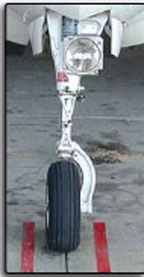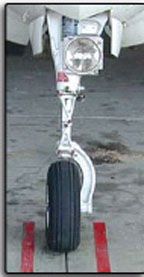During my now well over 2000 hours in Cessna 206 Stationairs, Id never thought much about a little under-inflation or a tad of over-inflation in the nose strut. And then it happened: my wife and I came within inches of serious injury-or worse-just because I departed with an over-inflated nose gear. The aircraft involved was just out of annual, fresh from a shop of four master mechanics Id been working with for 15 years. We departed a sea-level southern California airport in the early morning, with a planned fuel stop in northern Nevada some 3 hours later. Arriving downwind on the favored runway, I noted the strong crosswind and elected to land on the shorter easterly runway, right into the wind. The touchdown, given my sloppy approach due to the runway change, put me some 20-30 degrees off the centerline. Lots of time to correct once the rubber meets the asphalt. Or so I thought. Well, when the rubber met the asphalt, all hell broke loose. The Stationair, rolling along at 70 knots plus, stubbornly refused to obey any and all rudder inputs, no matter the pressures applied. I was living out the consequences of my sloppy approach, and my lackadaisical attitude toward the tad of over-inflation in my little old nose strut that Id noticed when pulling out the plane. Touching down at near 30 degrees off heading was irresponsible, stupid and entirely unnecessary. All decisions, all other options were compressed into two or three seconds time. Things were happening quickly-even though Id already spooled up to full throttle, left my landing flaps of 20 degrees alone and was raising the nose as much as I dared-the runway light was already shearing off. The touchdown had morphed into an emergency, for now, instead of slowing, I was lifting the nose, applying full power, clipping a landing light and cutting brush with the prop. It was terrifying. My now-overtaxed mind filled with but one question: “Would we be pulled down, into the high thick sage and plow into the desert soil, stopping instantly?” The Cessna 206 screamed and clawed for altitude. No stall warning sounded. We now knew it was over. We would live to fly another day, even as the horizontal stabilizer sliced the top buds off the blooming sage just beneath the Cessnas belly. Shortly, we were climbing away from the runway on the go-around. Our recovery and survival was not a function of skill, foresight, or careful preflight. Instead, we survived that day through dumb luck. And maybe a certain amount of proficiency in the 206. How many go-around accidents result from an over-inflated nose strut? Hard to say, for all evidence would be destroyed in the crash. We flew on to Kalispell, Mon., that day, but mostly in silence. And in thought. Sign me as, “Jimmy the Wiser.” ———- LEARNING EXPERIENCES Have you encountered a situation or hazardous condition that yielded lessons on how to better manage the risks involved in flying? Do you have an experience to share with Aviation Safetys readers about an occasion that taught you some-thing significant about ways to conduct safer flight operations? If so, we want to hear about it. We encourage you to submit a brief (500 words) write-up of your Learning Experience to Aviation Safety for possible publication. Each month, Aviation Safety publishes a collection of similar experiences sent to us by readers. Sharing with others the benefit of your experience and the lessons you learned can be an invaluable aid to other pilots. You can send your account directly to the editor by e-mailing it to mailto:[email protected]. Put Learning Experience Submission in the subject line; add your name and daytime telephone number at the bottom of the e-mail. Your report will be considered for publication in the Aviation Safetys readers forum, Learning Experiences, and may be edited for style and length. Anonymity is guaranteed. No one but Aviation Safetys editor is permitted access to the reports. Your name and telephone number are requested only so that the editor can contact you, if necessary, with any questions. While we cant guarantee your submission will get published, we can guarantee that well closely review and consider using it.All Learning Experience sub-missions become the property of Aviation Safety and may be republished.




